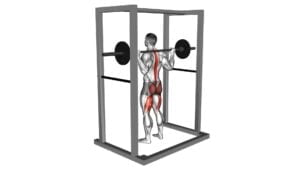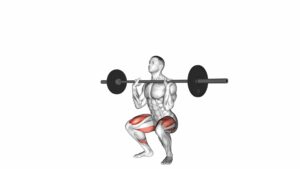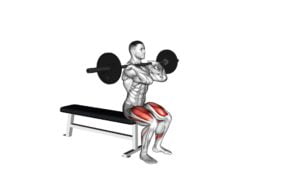Barbell Pin Front Squat – Video Exercise Guide & Tips

Looking to take your leg workout to the next level? Check out the Barbell Pin Front Squat!
Watch This Exercise Video
This video exercise guide and tips will show you how to properly perform this challenging yet effective exercise.
By targeting your quads, glutes, and core, the Barbell Pin Front Squat helps build strength and improve overall stability.
Follow along with the video and get ready to feel the burn!
Key Takeaways
- Improved weight distribution
- Increased demand on core muscles
- Enhanced balance and coordination
- Prevention of injuries and improved athletic performance
Benefits of the Barbell Pin Front Squat
The barbell pin front squat offers you numerous benefits for building strength and stability in your lower body. One of the key benefits is improved weight distribution. When you perform a front squat, the barbell rests on your shoulders in front of your body, as opposed to resting on your upper back in a traditional back squat. This shifts the weight forward and forces your core muscles, such as your abdominals and obliques, to work harder to maintain stability. This increased demand on your core muscles not only helps to strengthen them but also improves your overall balance and coordination.
Another benefit of the barbell pin front squat is enhanced core stability. As you lower yourself into the squat position, your core muscles engage to keep your torso upright and prevent you from collapsing forward. This constant activation of your core muscles helps to improve their endurance and strength over time. Additionally, a strong core is essential for maintaining proper posture and spinal alignment, which can prevent injuries and improve overall athletic performance.
Incorporating the barbell pin front squat into your workout routine can help you develop a strong lower body and improve your overall stability. By focusing on weight distribution and core stability, you won't only see improvements in your squatting technique but also in your overall functional strength.
Equipment and Setup
Now that you understand the benefits of the barbell pin front squat, let's discuss what equipment you'll need and how to set up for this exercise.
To perform the barbell pin front squat, you'll need the following equipment:
- Barbell: Use a standard Olympic barbell that's appropriate for your strength level. Make sure it's properly loaded with weights that challenge you but still allow for proper form.
- Power Rack: This is essential for setting up the pins at the appropriate height. Make sure the rack is stable and secure before using it.
- Pins: Adjust the height of the pins on the power rack so that the barbell rests just below shoulder level. This will allow you to safely unrack and rack the barbell during the exercise.
- Weight Plates: Place the appropriate weight plates on each end of the barbell. Start with a weight that allows you to maintain proper form and gradually increase the weight as you get stronger.
To set up for the barbell pin front squat, follow these steps:
- Position yourself in front of the power rack and adjust the pins to the desired height.
- Approach the barbell and grip it with your palms facing upwards. Your hands should be slightly wider than shoulder-width apart.
- Step forward and position the barbell on your shoulders, resting it on the front deltoids.
- Stand up straight and position your feet shoulder-width apart, toes slightly turned out.
- Brace your core and maintain an upright torso as you perform the exercise.
Proper Technique and Form
To ensure proper execution of the barbell pin front squat, it's crucial to maintain the correct technique and form. This won't only help you maximize the benefits of the exercise but also prevent injuries. Here are some key points to keep in mind:
- Start by positioning the barbell on the pins at shoulder height. Grip the bar with your palms facing forward, slightly wider than shoulder-width apart.
- Step forward and position your feet shoulder-width apart, with toes slightly turned outwards. This will provide a stable base for the movement.
- Keep your torso upright and engage your core muscles throughout the exercise. This will help maintain stability and prevent excessive leaning forward or backward.
- As you lower into the squat, focus on keeping your knees in line with your toes. Avoid letting them collapse inward, as this can strain the knee joints.
- Descend until your thighs are parallel to the ground or slightly below, then drive through your heels to return to the starting position.
Common errors to watch out for include rounding your back, allowing your knees to cave inwards, and lifting your heels off the ground. To improve your form, practice in front of a mirror, start with lighter weights, and seek guidance from a qualified trainer.
Common Mistakes to Avoid
What are some common mistakes to avoid when performing the barbell pin front squat? Proper execution is crucial for maximizing the benefits of this exercise and preventing injury. Here are three common mistakes to avoid:
- Leaning too far forward: One of the most common mistakes is leaning too far forward during the squat. This puts excessive strain on the lower back and reduces the effectiveness of the exercise. To avoid this, focus on keeping your chest up and your back straight throughout the movement.
- Lack of depth: Another mistake isn't squatting to the proper depth. Partial squats limit the activation of muscles and hinder overall strength gains. Make sure to lower yourself until your thighs are parallel to the ground, or even lower if you have the flexibility.
- Incorrect grip: The grip is often overlooked but is crucial for maintaining stability. Holding the bar too close or too far apart can throw off your balance and compromise your form. Aim for a grip that allows your elbows to be parallel to the ground and your wrists to be straight.
Variations and Modifications
To further enhance your training, there are several variations and modifications you can incorporate into the barbell pin front squat.
These alternative exercises can help target different muscle groups and add variety to your workout routine.
One variation you can try is the goblet squat. Instead of using a barbell, hold a dumbbell or kettlebell in front of your chest as you squat down. This exercise places more emphasis on the quadriceps and core muscles.
Another option is the dumbbell front squat. Hold a dumbbell in each hand and perform a front squat as you'd with a barbell. This exercise helps improve balance and stability while still targeting the lower body muscles.
If you want to focus on muscle activation techniques, you can incorporate pause squats into your routine. As you lower into the squat position, pause for a few seconds before coming back up. This forces your muscles to work harder and can lead to greater strength gains.
Additionally, you can try incorporating tempo squats, where you control the speed of your squat. This can be done by counting the seconds it takes to lower down and come back up. Slowing down the tempo can increase time under tension and improve muscle activation.
Tips for Progression and Safety
To ensure proper form and technique, it's important to focus on the key points of the barbell pin front squat.
Start by watching a proper form demonstration to understand the correct positioning and movement.
As you progress, gradually increase the weight to challenge your muscles and improve strength.
Proper Form Demonstration
Demonstrate proper form for the Barbell Pin Front Squat to ensure safe progression and maximum effectiveness in your workout.
- Engage your core and keep your chest up, with your feet shoulder-width apart.
- Place the barbell on the pins just below shoulder height, ensuring it's secure.
- Step under the barbell and position it across your front deltoids, gripping it with an overhand grip.
- Keep your elbows high and your wrists straight throughout the movement.
- Descend into a squat by bending at the knees and hips, keeping your back straight and knees tracking over your toes.
- Lower until your thighs are parallel to the floor, then push through your heels to return to the starting position.
- Repeat for the desired number of reps.
Front squat benefits include increased quad and glute activation, improved core stability, and enhanced upper body strength. Experiment with variations such as the goblet squat or the safety bar front squat to challenge your muscles in different ways.
Gradual Weight Increase
To safely and effectively increase the weight for your Barbell Pin Front Squat, follow these tips for progression and safety.
Gradually increasing resistance is a key component of weightlifting progression. Start by adding small increments of weight to your barbell, such as 2.5 to 5 pounds, depending on your current strength level.
It's important not to rush the process, as giving your body time to adapt to the added weight is crucial for avoiding injuries.
Focus on maintaining proper form and technique throughout the entire movement. If you can perform the exercise with ease and without sacrificing your form, it may be time to increase the weight slightly.
Frequently Asked Questions
How Many Sets and Reps Should I Do When Performing the Barbell Pin Front Squat?
When performing the barbell pin front squat, it's important to know how many sets and reps to do. To properly set up the exercise, make sure the pins are set at the appropriate height for your squat depth.
As for sets and reps, it depends on your fitness goals and experience level. Beginners may start with 3-4 sets of 8-10 reps, while more advanced lifters may do 4-5 sets of 6-8 reps.
Remember to avoid common mistakes like rounding your back and letting your knees cave in.
Can the Barbell Pin Front Squat Help Improve My Vertical Jump?
The barbell pin front squat is a great exercise for improving your vertical jump. By incorporating this exercise into your routine, you can benefit from increased lower body strength and power.
The barbell pin front squat specifically targets your quadriceps, glutes, and core muscles, which are essential for explosive movements like jumping. By consistently performing this exercise with proper technique and gradually increasing the weight, you can enhance your vertical jump and overall athletic performance.
Is It Necessary to Use a Spotter When Performing the Barbell Pin Front Squat?
When performing the barbell pin front squat, it's important to consider the necessity of using a spotter.
While it isn't absolutely required, having a spotter can provide added safety and support during the exercise.
A spotter can help you maintain proper form, prevent injuries, and assist with heavier weights.
Additionally, using a spotter allows you to push yourself to your maximum potential and achieve better results.
Can I Incorporate the Barbell Pin Front Squat Into My Lower Body Workout Routine?
Yes, you can definitely incorporate the barbell pin front squat into your lower body workout routine.
This exercise offers many benefits such as targeting your quadriceps, glutes, hamstrings, and core muscles.
To add variation, you can adjust the height of the pins, change the grip position, or even add resistance bands.
Remember to maintain proper form and start with a weight that you can handle safely.
Always consult with a fitness professional before starting any new exercise routine.
Are There Any Specific Warm-Up Exercises I Should Do Before Attempting the Barbell Pin Front Squat?
Before attempting the barbell pin front squat, it's important to properly warm up your body.
Start with dynamic stretches like leg swings and arm circles to loosen up your muscles.
Then, incorporate mobility exercises such as hip circles and shoulder rotations to improve your range of motion.
These warm-up exercises will help prepare your body for the demands of the barbell pin front squat and reduce the risk of injury.
Conclusion
In conclusion, the barbell pin front squat is a highly effective exercise for targeting the lower body muscles and improving overall strength and stability.
By properly setting up the equipment and using proper technique, you can maximize the benefits of this exercise and avoid common mistakes.
Remember to start with lighter weights and gradually increase the load as you progress.
Always prioritize safety and listen to your body to prevent injury.
Keep practicing and stay consistent to see great results.

Author
Years ago, the spark of my life’s passion ignited in my mind the moment I stepped into the local gym for the first time. The inaugural bead of perspiration, the initial endeavor, the very first surge of endorphins, and a sense of pride that washed over me post-workout marked the beginning of my deep-seated interest in strength sports, fitness, and sports nutrition. This very curiosity blossomed rapidly into a profound fascination, propelling me to earn a Master’s degree in Physical Education from the Academy of Physical Education in Krakow, followed by a Sports Manager diploma from the Jagiellonian University. My journey of growth led me to gain more specialized qualifications, such as being a certified personal trainer with a focus on sports dietetics, a lifeguard, and an instructor for wellness and corrective gymnastics. Theoretical knowledge paired seamlessly with practical experience, reinforcing my belief that the transformation of individuals under my guidance was also a reflection of my personal growth. This belief holds true even today. Each day, I strive to push the boundaries and explore new realms. These realms gently elevate me to greater heights. The unique combination of passion for my field and the continuous quest for growth fuels my drive to break new ground.







